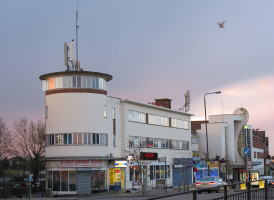
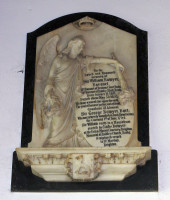
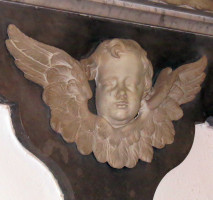

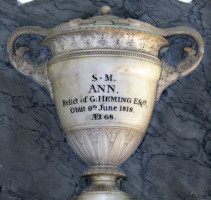
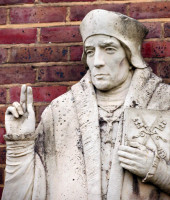
The Uxbridge branch of the Metropolitan Line, out to the west and north from central London, went mostly across fields until the late 1920s, when John Betjeman s Metroland was built the hundreds of thousands of houses detached, semi-detached and bungalows put up from about 1929-1935 that form London s north west suburbia. From where the Metropolitan line splits at Harrow (see this page for Harrow Parish Church monuments), the other branches of the line going west and north to Watford, Rickmansworth, Amersham and Chesham go to places with more of an ancient core, or at least a 19th Century one, and we expect some statuary, but surely not on the bland and suburban route to Uxbridge.
And yet, among the many streets and shopping centres and small green open spaces from Rayners Lane to Uxbridge at the end of the line, there is a goodly collection of statues and more minor sculpture, nearly entirely situated in the ancient parish churches. There are four of these along the line: at Ruislip, Ickenham, Hillingdon and in Uxbridge itself, and if we are willing to take a bit of a walk or bus ride away from the centre of Uxbridge or Hillingdon, two more, at West Drayton and Denham. All except the last of these is within the old county of Middlesex, swallowed up by London and reduced to little more than a postcode, and all bar the last two are within the borough of Hillingdon.
Recumbent statues Sir Edward Peckham & wife, Bust of Sir Roger Hill, Carr monument with kneeling figures, and Lord Paget reclining.
In this group of churches we have half a dozen grand tombs with busts or figure sculpture. The earliest is at Denham, a pair of recumbent figures representing Sir Edward Peckham, d.1570, and his wife. Also in Denham Church is the bust and splendid canopy to Sir Roger Hill, d.1729, and there are two busts in niches in St Mary s Church, Ruislip, to Raphe Hawtrey [Ralph Hawtrey], d.1647, and his wife Mary. Kneeler monuments the archetypical Tudor and Elizabethan monuments with statues of kneeling, praying figures often with lined up smaller figures of their offspring - are represented on the Uxbridge line by Sir Edward Carr, d.1636/7, and Dame Jane, his wife, in Hillingdon Church. The grandest monuments of all are the two cases of reclining figures on their sides, in the fashion of the noble Romans Dame Leonora Bennet, d.1638, at Uxbridge, and the Earl of Uxbridge, Lord Paget, d.1743, in the original parish church of Hillingdon.
Grand Classical monuments: Rupert Billingsley, Joseph Musgrave, John Walker and Edward Lockey.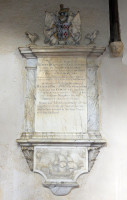
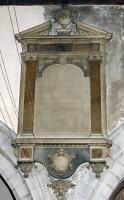
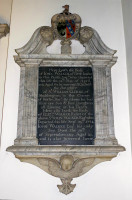
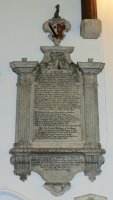
There are something like 150 lesser monuments wall panels or mural monuments across the six churches. Among the earlier ones are a series of grand Classical panels, great framed pieces of coloured marble and alabaster, enriched with heraldic shields, scrolling, pillars, scrolls and a variety of carved details. The best of these Classical panels date from Sir Roberte Peckham, d.1569, back in Denham, through nearly 200 years to Joseph Musgrave, d.1757 in Ruislip (see picture above) and Samuel Nicoll, d.1758, in Hillingdon. We should mention two grand panels with relief carvings of ships in full sail: to Rupert Billingsley, d.1725 (see picture above), in West Drayton, and to William Bowyer, d.1745 in Denham.
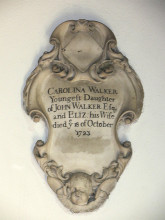
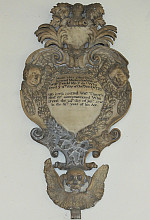 Cartouche monuments: Carolina Walker and Mariana Thorold.
Cartouche monuments: Carolina Walker and Mariana Thorold.
The churches on the Uxbridge Branch of the Met is also rich in cartouches, spanning from the mid-17th Century through to the mid-18th. Cartouches are the oval, heart shaped or violin shaped panels with richly sculptural surrounds incorporating scrolling, Acanthus leaves and cherub heads. They include Jane Clitheroe, d.1659 in Ruislip as the earliest example, another Samuel Nicoll, d.1723/4 in Hillingdon, and the archetypical cartouche monument to Mariana Thorold, d.1713, in Uxbridge (see picture above right), which includes two winged cherub heads, olive leaves and Acanthus, scrolling, lightly carved ribbons, a summit shield of arms with knight s helm on top, and at the base, a large death s head, or winged skull, as the memento mori equivalent of the cherub head. The last of the proper cartouches, I think, is that to Rupert Billingsley, d.1759, in West Drayton (a different one to that noted above), of interest as the surround is based entirely on carved drapery, flamboyantly knotted at the sides and hanging in twists and folds to a central, rather sad looking winged cherub head.
There are about eight obelisk or pyramid monuments in the Uxbridge line churches, which have a Classical panel lower portion and an upper portion cut in the shape of a tall obelisk, inspired by Egyptian themes of death and rebirth. The earliest is that to Elizabeth Bowyer, d.1736, in Denham, with a rather small obelisk, bearing a shield of arms with scrolly surround carved in relief; the one to Mary Clarke, d.1771 in Ickenham has several different coloured marbles in the construction, a taller and more typical obelisk, and a conventional narrow-stemmed pot upon it. The later examples towards the end of the Century bear relief figure sculpture carved upon the obelisks we return to these in a moment.
Obelisk monument to Elizabeth Bowyer and carved drape to Lady Ann Scott. 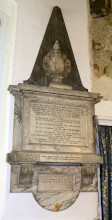
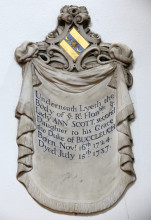
Occasionally we see wall panels carved in the form of a hanging cloth or drape, a bit like the Cartouche in that there is a raised upper centre, and knots at the tops of the sides, with hanging folds, but rather than a central inscribed panel, there is simply more hanging cloth, with the inscription carved on the creased and wrinkled surface. Such monuments, requiring extremely delicate carving to be successful, are unusual on the Uxbridge line, but a very beautiful example is at Denham, in the monument to Cecil Bowyer, d.1720, and simpler examples at Hillingdon (Hon. Lady Ann Scott, d.1737) and Uxbridge (Nathaniel Cowdery, d.1748).
Classical girls in high relief by the sculptor John Bacon Sr.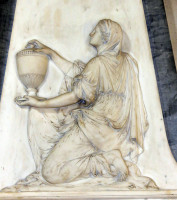
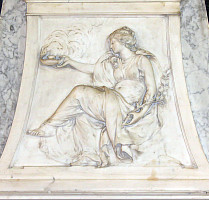
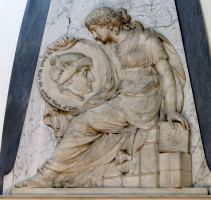
Back to figure sculpture. Aside from the grand monuments, and one to a Chrysom child, Robert Clayton, d.1665, at Ickenham, along the Uxbridge Line are several monuments showing figures carved in high relief, all dating from the three decades 1780-1810. The most popular is of course the mourning girl with Classical drapery. There are four examples by the sculptors John Bacon Senior and his son John Bacon Junior. At West Drayton are two personages called Fysh De Burgh, d.1793 and 1800, both by Bacon Sr, each with a lovely carving of a girl in profile, one with a pot, the other with an Aladdin-style lamp, and by the same artist, the monument to Thomas Lane, d.1795, in Hillingdon has another fine figure of a seated girl, this time holding a shield or plate bearing the low relief portrait of the deceased. His son, John Bacon Jr, was responsible for the figure on the monument to Catherine De Burgh, d.1809, again in West Drayton, with the girl holding a tall crucifix (there is a pot however on top of the portico under which she stands). In Ickenham, the monument to the Revd. Thomas Clarke, d.1796 has a small kneeling girl embracing a pot, and also there is the monument to John Clarke, d.1800, with a large figure of the deceased, shown sitting with a book, arm resting on his own tomb this is by the sculptor Thomas Banks. To complete the set, we should mention the small composition of an embracing pair of figures on the monument to Jabez Goldar, d.1780, in Uxbridge, and the late 19th Century panel showing an angel to Sir William Bowyer, Baronet, d.1893, back in Denham.
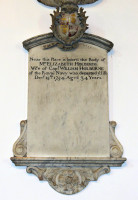
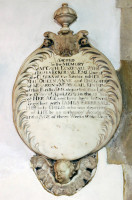 18th Century panels to Elizabeth Holburne and Catherine Eckersall
18th Century panels to Elizabeth Holburne and Catherine Eckersall
Scattered around the churches are various other 18th Century panels, some of which look to have lost their surrounding sculptural adornments, others never that ornamented in the first place, or what we may call lightly ornamented: we might take as examples the monument to Elizabeth Holburne, d.1754 at Denham, with little cartouche at the top, light carving at the base, and scrolls a the sides but looking as if it wanted more substantial side pilasters, and the oval panel to Catherine Eckersall, d.1772, in West Drayton, with delicate frame of fernlike fronds, and small cherub head at the base.
White on black Classical monuments of the early 19th Century: some characteristic shapes.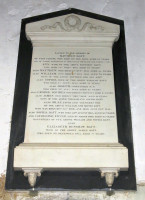
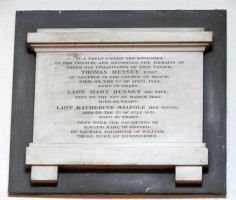
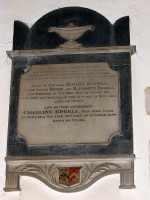
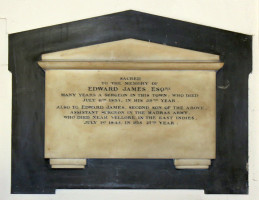
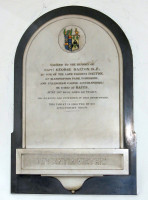
From around 1800 all the way through to late Victorian times, the monuments in the Uxbridge Line churches are dominated by rather simple panels in white marble on black backings, typically cut pieces of marble fitted together with rather little or no sculptural decoration. There are almost 50 of these across the six churches, or around 1/3 of all the monuments. We have a good range of the main types favoured at this time: in the shape of the end of a tomb chest, or bed-shaped monument with little feet and a shallow or flat lid, ( tomb chest end ), or as a casket, a taller design with a little pediment at the top and often a chunky base, and the occasional arched or shield shaped or oval design. Sculptural ornament, where there is any, might be a heraldic shield, a draped pot in relief on top, crossed branches, and minor scrolling. So for example the panel in Hillingdon Church to Francis Edgell, d.1819, has a relief pot and crossed branches behind a painted shield of arms, Easter De Burgh, d.1823, in West Drayton, has a panel with scrolly top and a base bearing crossed branches of oak and olive, and in the same church is the monument to General Arabin, d.1828, as a casket end, with pedimental top with carved acroteria ( ears ) and shield of arms, and in contrast the monument in Denham Church to Benjamin Way, d.1859, is carved as an unrolling scroll.
Victorian Gothic panels.
There was something of a revival of Gothic in Victorian times, with monuments in the form of blind windows of pale stone, with much tracery and the inscription, sometimes on marble, at the back of the window where the glass should be. There are just three examples on the Uxbridge Line, being another Revd. William Way, d.1845 and J.W.Drummond, d.1850 (picture above left), both in St Mary, Denham, and Daniel Macnamara (above right) of a decade later in Uxbridge.
Lieut. Fountain, d.1916, with mosaic and alabaster.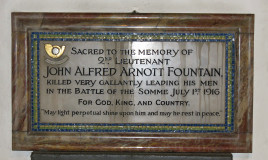
At the end of the 19th Century and through into the 1900s there was a late flowering of Arts and Crafts monuments in colourful alabaster, and on the Uxbridge Line there are a few, of which we show here the panel to Lieut. John Alfred Arnott Fountain, d.1916, with characteristic red-brown alabaster frame, and an inner frame in mosaic; it is in Ruislip. The dozen later monuments in the 20th Century are mostly plain and without sculptural decoration, in keeping with the reaction against ornament.
Details by John & Matthew Christmas, and by Joshua Marshall.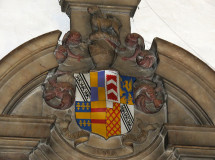
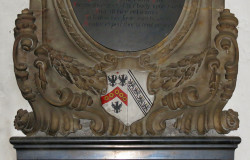
The artists who carved the monuments are often anonymous, but a number are signed, and a few are known from written sources. The earliest signed piece is the Hawtrey monument, 1647, already mentioned, by John and Matthew Christmas, and the cartouche to Jane Clitherow, d.1659, is attributed to Joshua Marshall - these are important sculptors of their day, and these monuments can both be seen in Ruislip Church. From the 18th Century is the panel to Hester Probert, d.1742, in Denham, by the sculptor Samuel Huskisson, and then from the end of the century, and early in the 19th Century, are the monuments by John Bacon Sr and John Bacon Jr already mentioned, as well as a further minor monument to Frances Clarke by Bacon Jr, at Ickenham.
Work by Burgiss of Uxbridge, and Tomlinson of Uxbridge.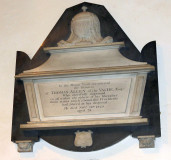
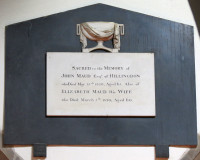
Of particular local interest is the relatively plain but competent work by the masons of Uxbridge: above all E. Burgiss, who has work at Ickenham, Hillingdon and West Drayton, and also John Tomlinson (Denham, Hillingdon and Uxbridge), and at Ickenham, the panel to Arthur Thornhill by Fassnidge and Son of Uxbridge, who is obscure.
From the 19th Century, already mentioned is the panel to John Clarke at Ickenham, which is by the eminent sculptor Thomas Banks, and at Ruislip, the panel to Juliana Wood is by the less well known but skilled sculptor Hinchliffe of Hampstead. There are several other signed pieces at West Drayton, including work by the masons Denman of Regent Street (William Arabin and General Arabin monuments) and Mullane of the New Road (Easter De Burgh), and by the notable Victorian sculptor G. G. Adams (Augustus De Burgh). At Ickenham is a plain panel by Gaffin of Regent Street (William Clarke-Thornhill monument), the most prolific of all 19th Century firms of monument makers. Several other works by more obscure masons may be found in the several churches.
William Arabin, Easter De Burgh, and Augustus De Burgh.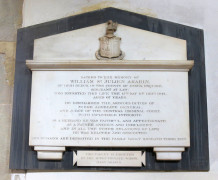
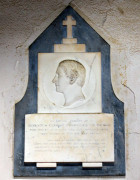
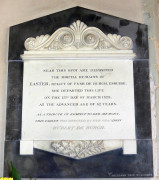
We note en passant that there are several brasses in the churches along the line, ancient and 19th Century revival. Outside in or close to the churchyards are various things, including churchyard crosses at West Drayton and Ruislip, the latter being a war memorial bearing a bronze crucified Christ, and at Uxbridge, where the churchyard is down the road from the ancient church, is a seriously large war memorial with a bronze angel by the sculptor Adrian Jones, as well as a drinking fountain, while at Ickenham is a village pump of mid-19th Century date. Of outdoor memorials per se, the best are at Hillingdon.
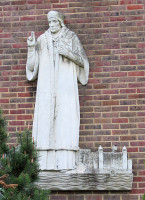
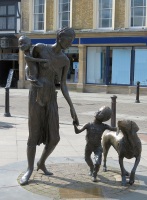 Statues of St John Fisher, Rayners Lane, and Anticipation, Uxbridge.
Statues of St John Fisher, Rayners Lane, and Anticipation, Uxbridge.
Outside and away from the churches, there really is very little sculpture along the Uxbridge Line. There is the odd 20th Century religious group, such as the statue of St John Fisher on the side of the outbuilding to the church of the same name in Rayners Lane, and a modern figure group called Anticipation, by Anita Lafford (2002) in Uxbridge, but it seems that the 350 years worth of sculptural ornament in the six churches has given almost no inspiration and impetus to sculpture in modern times in the area a shame.
Medieval churches at Ruislip, Ickenham, Hillingdon, Uxbridge, Denham and West Drayton.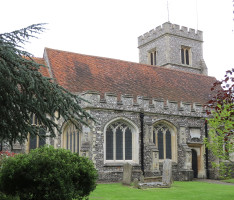
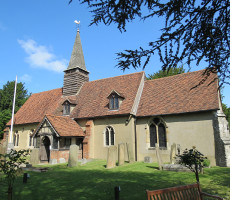
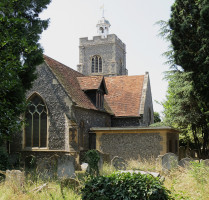
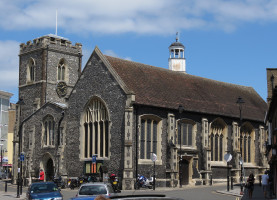
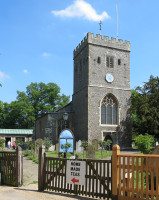
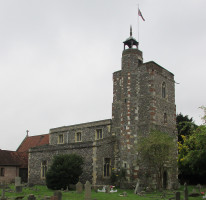
St Martin s Church in Ruislip dates from 1245 and is the oldest of the six churches along the Met Line to Uxbridge, with a tower of the 1500s. St John the Baptist Church in Hillingdon is 14th Century in the main, with the tower dating from 1629. St Margaret s Church Uxbridge has a late 14th Century tower, with the nave mostly 15th and 16th Centuries. St Giles Church, Ickenham, identified as an ecclesiastical building more by its short bell tower and steeple of the 15th Century rather than its nave of the late 14th-16th Centuries, is the odd one out in appearance. St Mary s Church in Denham still contains much 15th Century work, and St Martin West Drayton also mostly dates from the 15th Century. There were the usual spate of 19th Century restorations and alterations.
Rayners Lane 1930s architecture: former Cinema, Tower, Church and Metropolitan Chalet.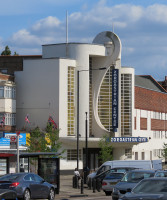
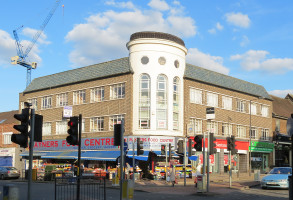
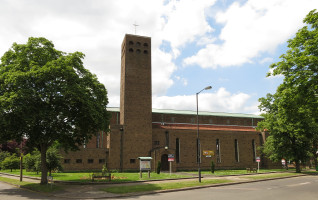
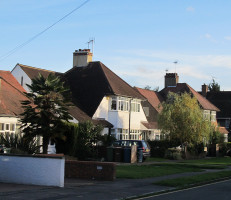
It should be mentioned that along the Uxbridge line, which as we recall from the top of the page, was built up in the late 1920s and early 1930s, is some iconic art deco architecture on a suburban scale. The very best of them are at Rayners Lane a station on the Uxbridge line mentioned above only for its statue, as it has no ancient church where is the former Cinema, with its elephant trunk front, and built at the same time, a splendid round tower. The area is also the home of some of the most inspired 1930s semi-Ds, in the so-called Metropolitan chalets in the several avenues leading off Village Way all angles and rooftops sweeping down to first floor level. Rayners Lane s main shopping parade, and some of the others along the line, were designed of a piece and have a sense of completeness about them, marred only somewhat by later developments. Right at the end of the line, at Uxbridge itself, is a mixture of 1930s, modern, earlier Victorian and Edwardian architecture, and a few much older things aside from the Church. Among the best of the 1930s buildings is the station itself.
More on Uxbridge Line Churches: Ruislip // Ickenham // Hillingdon // Uxbridge // Denham // West Drayton
Harrow Church, just to the East
Burgiss of Uxbridge, stonemason // Tomlinson of Uxbridge, stonemason
Monuments in some London Churches // Introduction to church monuments
Angel statues // Cherub sculpture
Visits to this page from 6 April 2015: 7,254